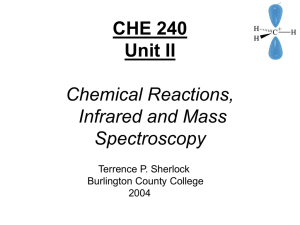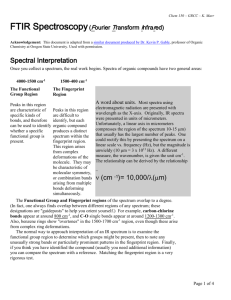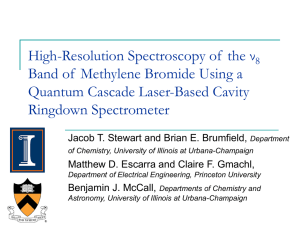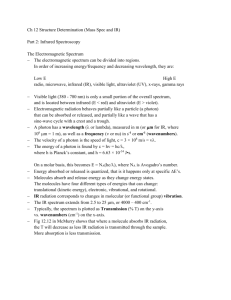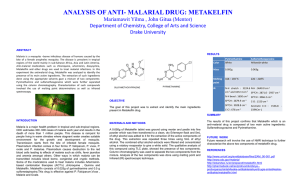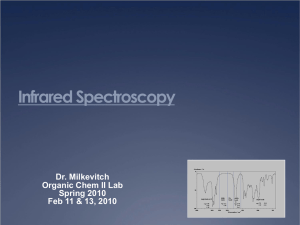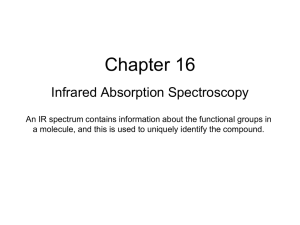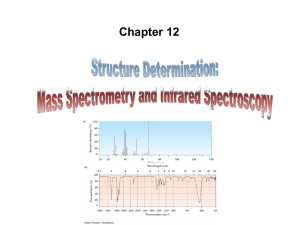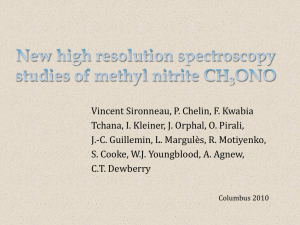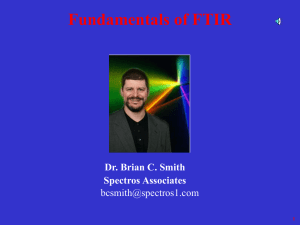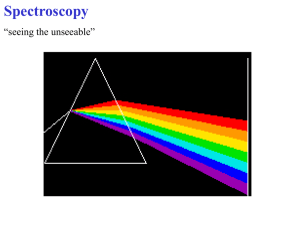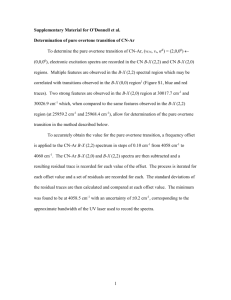Infrared Spectroscopy and Mass Spectroscopy
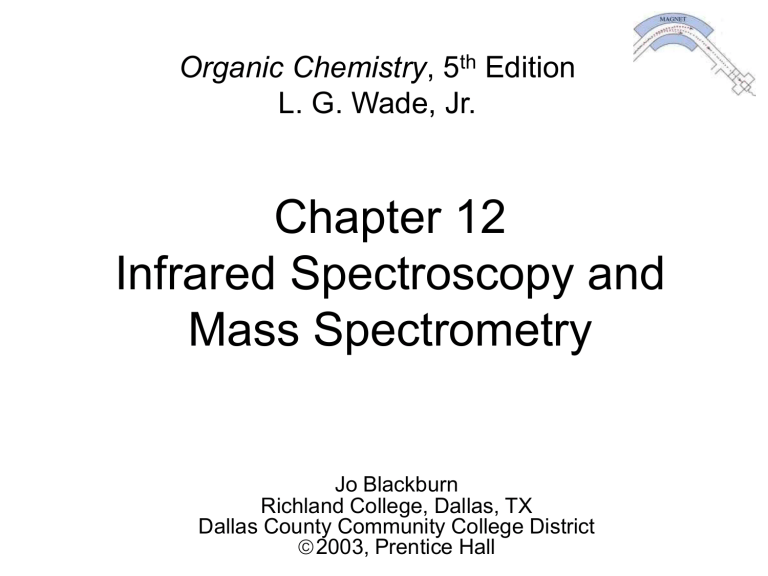
Organic Chemistry , 5 th Edition
L. G. Wade, Jr.
Chapter 12
Infrared Spectroscopy and
Mass Spectrometry
Jo Blackburn
Richland College, Dallas, TX
Dallas County Community College District
2003, Prentice Hall
Introduction
• Spectroscopy is an analytical technique which helps determine structure.
• It destroys little or no sample.
• The amount of light absorbed by the sample is measured as wavelength is varied.
=>
Chapter 12 2
Dorothy Crowfoot
Hodgkin
1910-1994
Chapter 12 3
Accomplishments
Chapter 12 4
Vit B-12
Chapter 12 5
Insulin
Chapter 12 6
Cholesterol Story
• Isolated in 1832
• Structure First reported in 1927
• Structure Determined in 1942 by Dorothy Crowfoot Hodgson
• Synthesized in 1971
Chapter 12 7
HO
Proposed by Wieland and Windaus
Nobel Prize to Wieland in 1927 and one to Windaus in 1929
*
*
*
*
*
*
*
*
As determined by Dorothy Crowfoot Hodgin
Note: 8 chiral centers or 256 possible stereoisomers
Chapter 12 8
Percy Julian
Just before the turn of the century, Percy Lavon Ju lian was born in
Montgomery, Alabama. He was a bright student, but a t that time the city p rovided no pub lic educ ation for black students after eighth grade. He persisted, however, and entered DePauw
University in Indi ana as a "sub-freshman." He had to take several classes to get caugh t up on what his public edu cation had not provided. Yet in 1920, he graduated first in his class with Phi
Beta Kappa honors.
Chapter 12 9
Cortisone
O
CORTISONE from soybeans
O
*
*
*
*
*
O
*
OH
OH
64 stereoisomers
Chapter 12 10
Photos
Chapter 12 11
Types of Spectroscopy
• Infrared (IR) spectroscopy measures the bond vibration frequencies in a molecule and is used to determine the functional group.
• Mass spectrometry (MS) fragments the molecule and measures the masses.
• Nuclear magnetic resonance (NMR) spectroscopy detects signals from hydrogen atoms and can be used to distinguish isomers.
• Ultraviolet (UV) spectroscopy uses electron transitions to determine bonding patterns. =>
Chapter 12 12
Electromagnetic
Spectrum
• Examples: X rays, microwaves, radio waves, visible light, IR, and UV.
• Frequency and wavelength are inversely proportional.
• c = ln
, where c is the speed of light.
• Energy per photon = h n
, where h is
Planck’s constant.
=>
Chapter 12 13
The Spectrum and
Molecular Effects
Chapter 12
=>
14 =>
The IR Region
• Just below red in the visible region.
• Wavelengths usually 2.5-25 m m.
• More common units are wavenumbers, or cm -1 , the reciprocal of the wavelength in centimeters.
• Wavenumbers are proportional to frequency and energy. =>
Chapter 12 15
Molecular Vibrations
Covalent bonds vibrate at only certain allowable frequencies.
Chapter 12 16
=>
Hooke’s Law n=
1/2 p c
. (t/m) t is directly proportional to bond strength: stronger the bond greater the frequency
So C=O [1700 cm -1] > C=C [1650-1600 cm -1 m is inversely proportional to reduced mass: the lighter the reduced mass the greater the frequency
Reduced mass = m
1 m
2
/m
1
+m
2
Consider C-H and C-D
12x1/12+1 =12/13
12x2/12+2 = 24/14
So C-H vibrates at a higher frequency than C-D
Chapter 12 17
Stretching Frequencies
• Frequency decreases with increasing atomic weight.
• Frequency increases with increasing bond energy.
=>
Chapter 12 18
Vibrational Modes
Nonlinear molecule with n atoms usually has
3 n - 6 fundamental vibrational modes.
19
=>
Chapter 12
Fingerprint of Molecule
• Whole-molecule vibrations and bending vibrations are also quantitized.
• No two molecules will give exactly the same IR spectrum (except enantiomers).
• Simple stretching: 1600-3500 cm -1 .
• Complex vibrations: 600-1400 cm -1 , called the “fingerprint region.”
Chapter 12
=>
20
IR-Active and Inactive
• A polar bond is usually IR-active.
• A nonpolar bond in a symmetrical molecule will absorb weakly or not at all.
21
=>
Chapter 12
An Infrared
Spectrometer
Chapter 12 22
=>
FT-IR Spectrometer
• Uses an interferometer.
• Has better sensitivity.
• Less energy is needed from source.
• Completes a scan in 1-2 seconds.
• Takes several scans and averages them.
• Has a laser beam that keeps the instrument accurately calibrated.
=>
Chapter 12 23
Carbon-Carbon
Bond Stretching
• Stronger bonds absorb at higher frequencies:
C-C 1200 cm -1
C=C 1660 cm -1
C
C 2200 cm -1 (weak or absent if internal)
• Conjugation lowers the frequency:
isolated C=C 1640-1680 cm -1
conjugated C=C 1620-1640 cm -1
aromatic C=C approx. 1600 cm -1
=>
Chapter 12 24
Carbon-Hydrogen
Stretching
Bonds with more s character absorb at a higher frequency.
sp 3 C-H, just below 3000 cm -1 (to the right)
sp 2 C-H, just above 3000 cm -1 (to the left)
sp C-H, at 3300 cm -1
=>
25 Chapter 12
An Alkane IR Spectrum
Chapter 12 26
=>
An Alkene IR Spectrum
Chapter 12 27
=>
An Alkyne IR Spectrum
Chapter 12 28
=>
Reduced mass
Bond Reduced mass IR Frequency, cm -1 Bond strength, kj mol -1
C-H 12/13 = 0.92 2900-3200 CH
4
: 440
N-H 14/15 = 0.93 3300-3400 NH
3
: 450
O-H 16/17 = 0.94 3500-3600 HOH: 500
Reduced masses are about the same; any difference between the position of the band (frequencies) must then due to bond strengths
Chapter 12 29
OH and NH stretching
Chapter 12 30
O-H and N-H
Stretching
• Both of these occur around 3300 cm -1 , but they look different.
Alcohol O-H, broad with rounded tip.
Secondary amine (R
2
NH), broad with one sharp spike.
Primary amine (RNH
2
), broad with two sharp spikes.
No signal for a tertiary amine (R
3
N) =>
Chapter 12 31
An Alcohol IR Spectrum
Chapter 12 32
=>
Intermolecular H-
Bonding
Chapter 12 33
Steric Hindrance to Hbonding
Chapter 12 34
An Amine
IR Spectrum
Chapter 12 35
=>
Carbonyl Stretching
• The C=O bond of simple ketones, aldehydes, and carboxylic acids absorb around 1710 cm -1 .
• Usually, it’s the strongest IR signal.
• Carboxylic acids will have O-H also.
• Aldehydes have two C-H signals around
2700 and 2800 cm -1 .
Chapter 12
=>
36
A Ketone
IR Spectrum
Chapter 12 37
=>
An Aldehyde
IR Spectrum
Chapter 12 38
=>
O-H Stretch of a
Carboxylic Acid
This O-H absorbs broadly, 2500-3500 cm -1 , due to strong hydrogen bonding.
Chapter 12 39
=>
Variations in
C=O Absorption
• Conjugation of C=O with C=C lowers the stretching frequency to ~1680 cm -1 .
• The C=O group of an amide absorbs at an even lower frequency, 1640-1680 cm -1 .
• The C=O of an ester absorbs at a higher frequency, ~1730-1740 cm -1 .
• Carbonyl groups in small rings (5 C’s or less) absorb at an even higher frequency.
=>
Chapter 12 40
An Amide
IR Spectrum
Chapter 12
=>
41
Carbon - Nitrogen
Stretching
• C - N absorbs around 1200 cm -1 .
• C = N absorbs around 1660 cm -1 and is much stronger than the C = C absorption in the same region.
• C
N absorbs strongly just above 2200 cm -1 . The alkyne C
C signal is much weaker and is just below 2200 cm -1 .
=>
Chapter 12 42
A Nitrile
IR Spectrum
Chapter 12 43
=>
Summary of IR
Absorptions
Chapter 12 44
=>
=>
Strengths and Limitations
• IR alone cannot determine a structure.
• Some signals may be ambiguous.
• The functional group is usually indicated.
• The absence of a signal is definite proof that the functional group is absent.
• Correspondence with a known sample’s
IR spectrum confirms the identity of the compound.
=>
Chapter 12 45
Mass Spectrometry
• Molecular weight can be obtained from a very small sample.
• It does not involve the absorption or emission of light.
• A beam of high-energy electrons breaks the molecule apart.
• The masses of the fragments and their relative abundance reveal information about the structure of the molecule.
Chapter 12 46
Mass Spectrometry
THE MAIN USE OF MS IN ORG CHEM IS:
• DETERMINE THE MOLECULAR MASS OF
ORGANIC COMPOUNDS
• DETERMINE THE MOLECULAR FORMULA OF
ORGANIC COMPOUNDS
Chapter 12 47
HOW DO WE
ACHIEVE THIS?
• PERSUADE THE MOLECULE TO ENTER
THE VAPOR PHASE (CAN BE DIFFICULT)
• PRODUCE IONS FROM THE MOLECULES THAT ENTER
THE GAS PHASE
• SEPARATE THE IONS ACCORDING TO THEIR
MASS-TO-CHARGE RATIOS (m/z))
• MEASURE AND RECORD THESE IONS
Chapter 12 48
IONIZING METHODS
• ELECTRON IMPACT - HIGH ENERGY
ELECTRONS ABOUT 70 EV!!
• CHEMICAL IONIZATION LOW ENERGY
Chapter 12 49
ELECTRON IMPACT
H
H-C:H
H
+ e
H
H-C
H + 2e CH
4
H
RADICAL CATION
H
H-C
H
H
BOND-BREAKING
H
H-C
H
+ + H
RADICAL
CATION
H
H-C
H
ONLY CATIONS ARE CARRIED TO DETECTOR
Chapter 12
+ H
+
50
MS of METHANE
Molecular ion base peak fragments
1 m/z mass measurement takes about 20 m secs many fragmentations occur
So what does a typical ms looks like????
Chapter 12
15 16
51
Alarm Pheromone of Honey Bee
Typical Mass Spectrum
100%
43 base peak given 100% abundance
50%
58
NOTE: 114-71 = 43
NOTE: 43 = mass of radical
71
114 molecular ion m/e
Chapter 12
Isotope peaks - P+1,
P+2, etc
52
Electron Impact Ionization
A high-energy electron can dislodge an electron from a bond, creating a radical cation (a positive ion with an unpaired e ).
H H
H e + H C
H
H
C
H
H
H C
H
C
H
H
H
H C
H
H
C + H
H
Chapter 12
H
H C +
H
H
C
H
H
Separation of Ions
• Only the cations are deflected by the magnetic field.
• Amount of deflection depends on m/z .
• The detector signal is proportional to the number of ions hitting it.
• By varying the magnetic field, ions of all masses are collected and counted.
=>
Chapter 12 54
Mass Spectrometer
Chapter 12 55
=>
The Mass Spectrum
Masses are graphed or tabulated according to their relative abundance.
Chapter 12 56
=>
The GC-MS
A mixture of compounds is separated by gas chromatography, then identified by mass spectrometry.
Chapter 12 57 =>
High Resolution MS
• Masses measured to 1 part in 20,000.
• A molecule with mass of 44 could be
C
3
H
8
, C
2
H
4
O, CO
2
, or CN
2
H
4
.
• If a more exact mass is 44.029, pick the correct structure from the table:
C
3
H
8
C
2
H
4
O CO
2
CN
2
H
4
44.06260
44.02620
43.98983
44.03740
=>
Chapter 12 58
Molecules with
Heteroatoms
• Isotopes: present in their usual abundance.
• Hydrocarbons contain 1.1% C-13, so there will be a small M+1 peak.
• If Br is present, M+2 is equal to M + .
• If Cl is present, M+2 is one-third of M + .
• If iodine is present, peak at 127, large gap.
• If N is present, M + will be an odd number.
• If S is present, M+2 will be 4% of M + .
=>
Chapter 12 59
Isotopic Abundance
Chapter 12
81 Br
=>
60
Mass Spectrum with Sulfur
Chapter 12
=>
61
Mass Spectrum with Chlorine
Chapter 12 62
=>
Mass Spectrum with Bromine
Chapter 12 63
=>
Mass Spectra of Alkanes
More stable carbocations will be more abundant.
Chapter 12 64
=>
Mass Spectra of Alkenes
Resonance-stabilized cations favored.
Chapter 12 65 =>
Mass Spectra of Alcohols
• Alcohols usually lose a water molecule.
• M + may not be visible.
Chapter 12 66
=>
End of Chapter 12
Chapter 12 67
